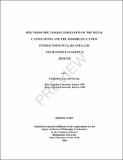| dc.description.abstract | Toxic chemicals are abundant in the environment and their detection often requires very
costly and time consuming methods. Where such molecules are able to interact with the
transition metal cations, their characteristic electronic transitions are identifiable by
spectroscopic methods and provide a potential means of simple identification.
Zeolites offer a very porous and polar solid-state environment that attracts molecules
and stabilizes cations, hence enabling complexes to form in it.
In this work, the Co2+ and Cu2+ complexes of ammonia, pyridine, acetone, water and
sulfur dioxide in zeolite-X were characterized by UV-Vis reflectance, electron
paramagnetic resonance, infrared and nuclear magnetic resonance spectroscopic
methods. At lower concentrations (such as at 1 copper per unit cell (1 Cu/UC), the
cations were found to bind the framework oxygens at the Si(OAl)4 tetrahedra. The
exchanged cations at low concentrations reside in site I΄ where two Cu2+ species (I and
II) are seen to emerge, as a result of different local charges. Apart from water, other
adsorbates do not interact with the exchanged cations at low concentration (1 Cu/UC).
Higher exchange levels of the cations are found to occupy supercage sites of II΄ and
possibly III. As the concentration of the cations increases to ca. 8 Cu/UC, dynamic spinspin averaging begins to take place. Thus, at ≥ 8 Cu/UC, CuX continuous-wave EPR
(CW-EPR) spectra have contributions from both the dynamic spin-spin averaging and
some residual static powder pattern spectrum of isolated Cu2+.
iv
PREVIEW
In the supercage accessible cation sites, ammonia and pyridine showed interactions with
cations at single four-ring site III (S4R (III)), whereas acetone and water coordinate the
cations at single six-ring site II’ (S6R (II΄)). Sulfur dioxide showed little evidence of
reaching the cations at any cation exchange levels. The presence of the adsorbates in the
highly Cu2+ exchanged samples did not eliminate the occurrence of dynamic spin-spin
averaging among the proximate Cu2+ ions. This broad range of results gives us a
characteristic ordering of ligand field strengths of ammonia > pyridine > Ozeo ≥ acetone
≈ water > sulfur dioxide. | en_US |

